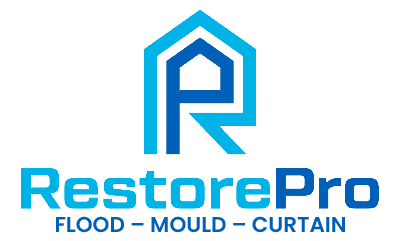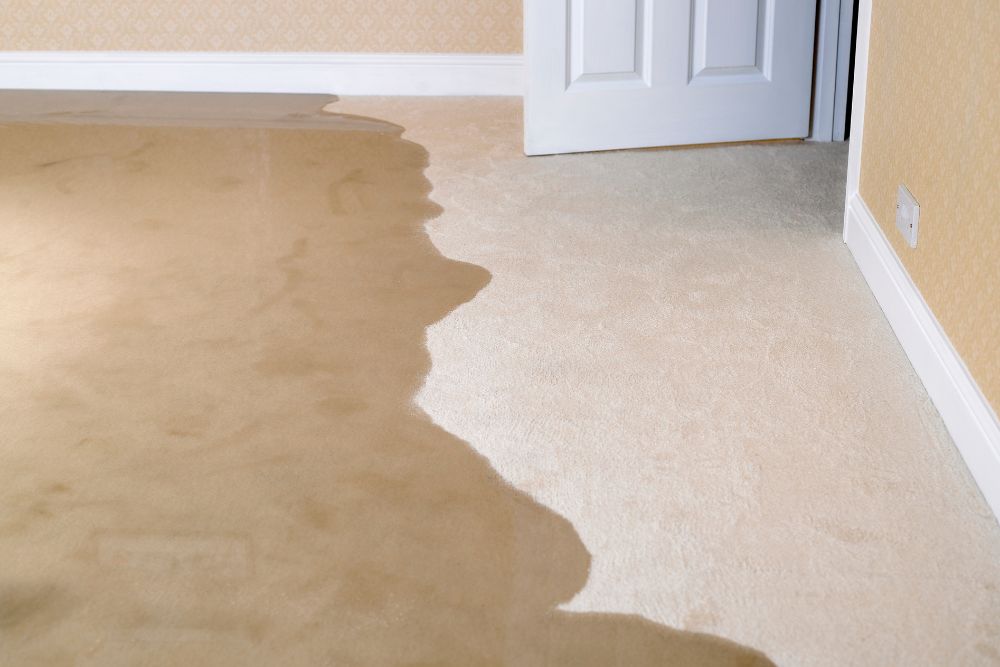When your carpets are damaged by flooding, the first thing to do is quickly check how bad the damage is. You need to see how wet the carpets are and if the water was clean or dirty.
If the flooding is minor, you might be able to handle the cleaning yourself with high-performance equipment to remove the water and speed up drying. However, if the damage is more serious, it is important to get a professional to check it to prevent long-term problems like mould and damage to the building’s structure.
Initial Assessment Of Flood Damage on Carpet
The first thing you need to do is evaluate the extent of flood damage on your carpet. Check for water saturation, colour changes, and any unpleasant odours. Feel the carpet and the padding below to see how deeply the water has penetrated. If the carpet is thoroughly soaked, it is important to act swiftly to prevent further damage.
Look for signs of mould growth or a musty smell, which suggest that the carpet has been wet for some time. Check for warping or delamination, where the carpet separates from its backing, as these indicate serious damage.
It’s also crucial to identify the source of the flooding. Whether it’s a burst pipe, overflow, or natural disaster, knowing the cause will help in preventing future incidents. Address these underlying issues quickly to avoid recurrence.
Water Removal Techniques from Flooded Carpets
Effective Pump Usage
To effectively remove water from your flooded carpet, use a robust pump or shop vacuum. This tool is crucial for quickly extracting substantial amounts of water, which helps prevent the growth of mould and mildew.
Begin by placing the pump or shop vacuum at the lowest point on the carpet. This approach ensures maximum water removal, as water naturally flows downhill. Move the equipment regularly to thoroughly cover all affected areas. Keep an eye on the fill level and empty the collected water as necessary to keep the machine working efficiently.
If water keeps seeping into the carpet after several attempts with the pump, consider contacting a professional. Continuing seepage suggests a more serious issue, perhaps due to broken pipes or groundwater, which may require specialised equipment to manage.
Once you have removed as much water as possible, set up fans and a dehumidifier in the affected area to speed up the drying process. Avoid using hairdryers, as they can further damage the wet carpet fibres.
Absorbent Towels Application
After you have extracted the water using a pump or shop vacuum, place absorbent towels on your carpet to soak up any leftover moisture. These towels are essential for absorbing excess water, reducing the risk of damage, and speeding up the drying process.
To be most effective, use a mix of dabbing and pressing actions. This technique helps the towels absorb more water without spreading the moisture further. Spread the towels flat over the damp areas of your carpet. Press down hard to help the towels absorb the water. You may find it useful to walk on the towels or use your hands to press down harder. The aim is to move as much water as possible from the carpet into the towels.
Ensure you change the towels frequently. Once a towel is soaked, swap it for a dry one to keep removing moisture effectively. Continue this process until the towels no longer absorb a significant amount of water.
Drying and Dehumidifying Processes
After a flood, it’s crucial to address the moisture in your carpet to prevent mould growth and further damage. Here is a clear method to ensure your carpet is restored to its condition before the flood:
1. Set Up Fans and Dehumidifiers
Start by arranging fans throughout the affected area to enhance air circulation. At the same time, place dehumidifiers to remove moisture from the air. Using both devices together greatly accelerates the drying process and increases its effectiveness.
2. Ensure Proper Ventilation
Open windows and doors to let fresh air in, which aids in lowering the humidity inside. This step is vital as it helps the dehumidifiers work more efficiently by constantly replacing the moist indoor air with drier outdoor air.
3. Regularly Check Dryness
It is important not to simply set up equipment and leave it. You must frequently check the moisture content of your carpet. Use moisture meters to determine if the carpet is drying uniformly and effectively. Adjust the placement of fans and dehumidifiers based on these readings to improve the drying process.
Carpet Padding Replacement
You need to check your carpet’s underlay for signs of mould after it has been water-damaged. If the underlay has not dried out properly, it is very important to think about taking it out or replacing it to stop mould from growing. Mould can be a real health risk and can also spoil the air quality in your home.
Once you have checked the condition of your carpet underlay, the next step is to remove any damaged material. It is essential to dispose of it safely to prevent any health hazards. Make sure to check local rules to ensure you are disposing of it the right way.
It is often wise to get professional help to make sure the new underlay is fitted properly. Professionals have the right tools and expertise to install new underlay that matches your carpet’s requirements and guarantees lasting comfort and durability.
Carpet Cleaning and Sanitisation
After replacing the underlay, it is also essential to clean and sanitise your carpet thoroughly to remove any pollutants or smells left by the flooding. Here are three effective steps to clean and sanitise your flood-damaged carpet:
- Use Enzyme Cleaners or Homemade Solution: Apply enzyme cleaners that are suitable for carpets. These help break down organic material and bacteria brought in by the water. Alternatively, you can use a homemade solution of white vinegar, which aids in eliminating odours and sanitising.
- Steam Cleaning: Steam cleaning is crucial for deep sanitisation. It reaches deep into the fibres and padding, killing germs and mould spores that may have begun to grow. This method also helps remove dirt and residues embedded deep in the carpet.
- Deodorise with Baking Soda: After steam cleaning, generously sprinkle baking soda over the carpet. Leave it for several hours or overnight to absorb any remaining smells. Vacuum it up thoroughly to remove the baking soda and any trapped odours.
Ensure you also sanitise the walls and skirting boards to prevent any health risks.
Professional Restoration Services
When your carpets are damaged by flooding, it is essential to seek professional flood restoration services. These experts use specialised equipment to effectively remove water and restore your carpets.
Professional restoration services address flood damage on carpets by offering water extraction, drying, sanitising, deodorising, and repair. When you experience a flood, these specialists come prepared with the necessary knowledge and tools to clean and restore your carpet to its original condition. Here’s what you can expect when you hire professional services:
- Thorough Damage Evaluation: Certified technicians will examine the damage to determine the most effective restoration method. This includes inspecting the carpet, its padding, and the subfloor.
- Mould Prevention Measures: Professionals apply comprehensive drying and sanitising techniques to prevent the growth of mould and mildew, which are common issues after floods.
- Quality Check After Restoration: After the cleaning and repair process, a final check ensures that the work meets high standards, protecting your health and investment.
Opting for professional restoration services ensures a comprehensive approach, addressing both visible and underlying flood damage. They handle everything from carpet padding replacement to structural drying, ensuring your home is fully restored and safe.
Dealing with Flood and Water Damage on Your Carpets?
Don’t let flood damage compromise your home’s safety and value. Consider RestorePro’s flood and water damage restoration services—a trusted solution to restore and protect your property.
Act now to prevent long-term damage and health risks. For professional and reliable restoration, contact RestorePro today at 0800 843-776 or email us at info@restorepro.co.nz.
Don’t wait for the damage to worsen; ensure your home’s safety and integrity with RestorePro’s expert services!

